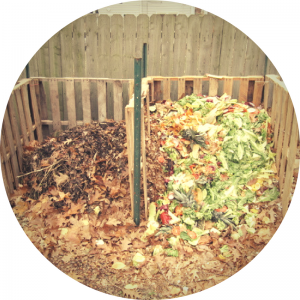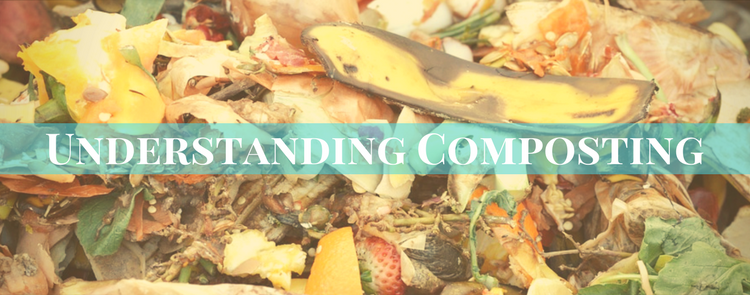Understanding Composting
Composting can be as simple or as complex as you want to make it. The best part about creating compost is that it can consist of any organic material and we all have access to plenty of that every single day because it is produced by the lawn, garden, and kitchen.
 Compost is what happens when leaves, grass clippings, vegetable and fruit scraps, woodchips, straw, and small twigs are combined, then allowed to break down into a soillike texture. Compost introduces and feeds diverse life in the soil, including bacteria, insects, worms, and more which support vigorous plant growth.
Compost is what happens when leaves, grass clippings, vegetable and fruit scraps, woodchips, straw, and small twigs are combined, then allowed to break down into a soillike texture. Compost introduces and feeds diverse life in the soil, including bacteria, insects, worms, and more which support vigorous plant growth.
Compost is multi-faceted but not intended as a fertilizer. It offers only a relatively low proportion of nutrients, yet what it does is close to magical. In its finished form as mulch, it reduces evaporation, reduces or prevents weed growth, and insulates the soil from extreme temperature changes. Mulch also keeps the upper inches of the soil cooler in daytime, warmer at night.
Check Out: Worm Composting for an Organic Garden
Yet compost has humble beginnings. Common, easily accessible materials destined to decay together in a pile will give your soil the gift of minerals and other components it needs. The materials are indeed numerous.
Regardless of the particular ingredients, making compost is akin to making bread or beer; soil-digesting bacteria like yeasts need warmth, moisture, air and something to feed on to keep them alive and growing.
Almost all of the practical problems associated with making compost stem from too much or too little of those basic factors.
 Compost is created from layers of grass clippings, leaves, weeds, kitchen scraps and, if available, farm animal manure. If you have meat eaters in your home, don’t use their meat scraps, which will attract rodents. Also, do not use litter from your dog or cat; it doesn’t break down properly and contains too many pathogens.
Compost is created from layers of grass clippings, leaves, weeds, kitchen scraps and, if available, farm animal manure. If you have meat eaters in your home, don’t use their meat scraps, which will attract rodents. Also, do not use litter from your dog or cat; it doesn’t break down properly and contains too many pathogens.
Over the years, composting has gotten a reputation for being a time-consuming job, but this is not necessarily the case. You don’t need to build a big box or turn the pile every so often. A barrel, a hole in the ground or a pile on top of the ground is satisfactory.
The important requirement is to be sure the waste material is covered with soil, so it doesn’t attract rats, other rodents or flies. You can build your layers directly on the ground, without any frame at all; if you use a container, be sure it is well ventilated.
Check Out: Ultimate Compost Tea Guide
The trick to successful compost is balancing ingredients high in nitrogen–fresh grass clippings, other fresh, green plant matter, most kitchen scraps–with those high in carbon–leaves, straw, dried grass, washed eggshells, wheat germ or other milled grains that have become too rancid or old to use, and any dried, brown plant matter. Too much nitrogenous matter yields an anaerobic, smelly pile. Too much carbonaceous matter results in a pile that never heats up. The ideal ratio is one part nitrogen to three parts carbon.
Start with a layer of brush–small twigs, no large branches–a couple of inches deep; this will help your pile to breathe. Then, keeping in mind the 1 to 3 ratio of nitrogen to carbon, add a layer of mixed plant material. You may enrich the pile with horse or cow manure. These materials don’t break down; they simply add nutrients to the final product.
Then lightly water the pile so it’s evenly moist. Too much water will interfere with aeration; too little water and the pile won’t ferment. If your pile sits in the open, you should pull a tarp over it before a storm, and then remove the tarp after the rain stops so the pile can breathe. An 8- inch layer of straw mulch spread over the top of the pile serves the same purpose.
Alternate layers until the pile is 5 feet high by 5 feet wide by whatever length you choose. A properly made pile that is loosely packed and well aerated will reach an internal temperature of 160 degrees within a few days. It should smell like wet hay. If the pile fails to heat up, pull it apart and redo it by adding layers of fresh green matter. If the pile becomes anaerobic (is too wet to aerate), pull it apart, let it dry out, use it as mulch and start a new pile.
After three weeks, the pile will have shrunk in size; this is normal. Dig into the pile with a spading fork and completely turn it over until the contents are redistributed; the idea is to put unfermented particles in contact with those that are further along. Let the pile rest, so the temperature will rise again. Turn it a second time five weeks later, let it rest a few weeks and, with luck, you’ll have a rich, crumbly pile of “black gold.”
 Also, air is vital to any composting process. Without air (anaerobic) composting is possible but unpleasant with the putrescent of rotting material assaulting your nose. It is usually because there is too much nitrogen and too little air in the mixture. If you have an abundance of trees on your property, autumn leaves can be plentiful and messy, but they are there for your use and can be easily gathered and stored in leaf bags.
Also, air is vital to any composting process. Without air (anaerobic) composting is possible but unpleasant with the putrescent of rotting material assaulting your nose. It is usually because there is too much nitrogen and too little air in the mixture. If you have an abundance of trees on your property, autumn leaves can be plentiful and messy, but they are there for your use and can be easily gathered and stored in leaf bags.
Timing is crucial. Your pile is fully composted when it fails to heat up after being turned. Then it is ready to use.
And use it with a good feeling, for it is your garden’s natural fuel. Remember your objective, the foundation of every successful garden, is to achieve healthy soil.
Compost supplies the soil with a rich, friable source of humus and helps retain moisture in the garden, in addition to supplying valuable nutrients. By placing grass clippings, fallen leaves and unused plant parts in a compost pile, you are preparing them, through decomposition, to be put back to work for you.
Composting actually recycles garden waste and returns the nutrients that have been taken from the soil. By using organic composting agents, it is possible to speed-up the process of decomposition.



Comments are closed, but trackbacks and pingbacks are open.